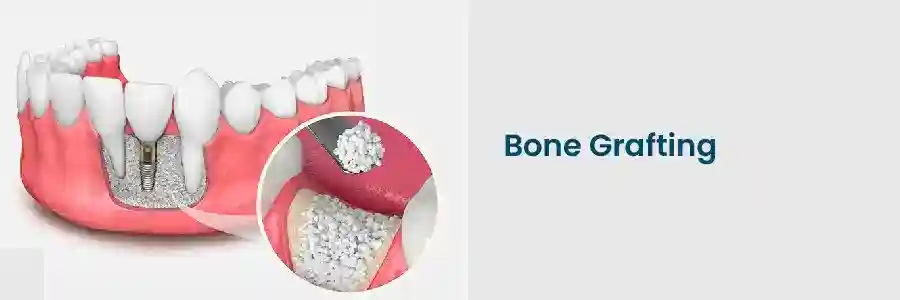
What is bone grafting?
Bone grafting is a surgery to place new bone or bone substitutes into the spaces around a broken bone or bone defect.As effective as bone grafts might be in repairing arms and legs, bone grafts are also regularly placed in dental treatments. Dental bone grafts are placed in the areas of the jaw where bone loss has occurred to add bone density and volume. Without adequate bone within the jaw area, individuals are susceptible to all sorts of oral health issues. Teeth may shift, infections might arise, and the jaw will be vulnerable to breakage.
Why is bone grafting recommended?
The doctor may recommend bone grafting for the following conditions:
- Bone diseases like bone cancer
- Rebuilding a fractured bone
- Fusing bones of a joint
- Treating a fracture that is not healing
- Replacing a missing tooth(dental implant surgery)
- A previous fracture that is not healed properly
- Filling gaps in bones caused due to tumors or cysts
- Expediting bone growth
- Alveolar bone grafting to treat cleft palate
What are the different types of bone grafts?
There are several bone grafting methods, including:
Allograft
This method makes use of another person's bone tissue (donor). The bone tissue is cleaned and processed (sterilized) to ensure the recipient's safety. It is commonly used in spinal fusion surgery. It serves as a framework for the development of healthy bone tissue.
Autograft
A portion of your own bone tissue is used in an autograft. The tissue is usually derived from the part of your hip bone (iliac crest). The surgeon makes a cut to obtain the bone tissue. The advantage of using your tissue is that it increases the likelihood of successful fusion. However, the amount of bone tissue that can be collected is limited. You may also experience pain at the site where the bone graft is collected.
Bone marrow aspirate
Bone marrow aspirate: A marrow is a spongy substance found within bones. It contains stem cells, which can help in the healing of fractured bones. The surgeon obtains bone marrow from the hip bone(iliac crest) with a needle. This bone marrow aspirate is used alone or in combination with other bone grafts to improve bone healing after allograft surgery.
Synthetic bone graft
This graft makes use of synthetic materials made from a variety of porous substances. Some also contain proteins that promote the development of bones.
Secure your health with a second opinion. Make informed decisions and book your appointment today!
Get A Second OpinionWhat are the risks of bone grafting?
All bone grafting procedures come with risks. They include:
- Blood loss
- Infection
- Problems with bone healing
- Chronic pain
- Fractures
- Screws and plates fail to hold the graft in place
- Scarring
Citations
HealthBone Grafting
Bone graft
Bone Graft Types
Bone Grafting
Secure your health with a second opinion. Make informed decisions and book your appointment today!
Book an AppointmentFrequently Asked Questions
Bone grafts can be taken from different parts of your own body (autologous), cadaveric bone obtained from bone banks (allograft), or synthetic sources(alloplasts) with similar mechanical properties to bone..
No, The bone grafts taken from a cadaver are made sterile using International standardized protocols. Hence no infections occur because of the graft..
As with all surgical procedures, there is a risk of pain, swelling, bruising, bleeding and infection. Minimal chances of graft rejection do exist. All these complications can be avoided when proper diagnostic, sterilization and surgical protocols are followed..
The length of the procedure is determined by the complexity of the case and the size of the bone that must be harvested or fixed. The majority of bone graft surgeries take between 1-2 hours..
Bone grafts are most often needed to heal bone fractures. A doctor may recommend that a patient get a graft if they believe that a fracture won't heal well or if a previous fracture that was not treated with a graft has not healed well on its own..
